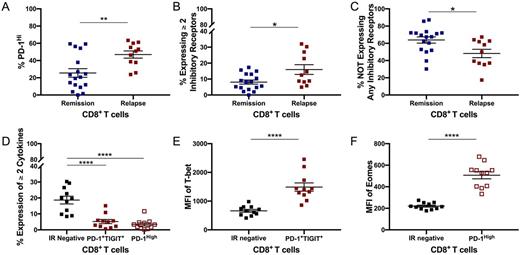Abstract
Allogeneic hematopoietic stem cell transplant (alloSCT) is curative for patients with high-risk acute myeloid leukemia (AML) and acute lymphoblastic leukemia (ALL). Despite this, relapse remains the leading cause of treatment failure. The use of flow cytometry to identify aberrant leukemia-associated immunophenotypes is an established method of detecting minimal residual disease (MRD). MRD status immediately prior to transplant remains one of the single best predictors of post-transplant outcome. Unfortunately, not all MRD(-) patients maintain remission post-transplant. Therefore, we sought to find additional predictors of post-transplant relapse. T cell exhaustion occurs following continuous exposure to antigen and leads to sustained up-regulation of multiple inhibitory receptors, progressive loss of function, and expression of a distinct transcriptional state. Bachireddy et al recently reported that exhausted CD8+ marrow infiltrating lymphocytes (MILs) were a novel predictor of response to donor lymphocyte infusion (DLI) for patients with relapsed chronic myelogenous leukemia (CML). Based on this principle, we hypothesized that exhausted CD8+MILs may also be predictive of outcome for MRD(-) patients prior to alloSCT.
We matched pre-transplant samples from 17 MRD(-) patients who maintained remission for greater than 2 years post-transplant to 11 MRD(-) patients who suffered relapse within 2 years of transplant. Patients had either ALL or AML and did not differ by demographic details. MILs were evaluated for exhaustion using 2 multicolor flow cytometry panels which collectively included a viability dye, T cell markers (CD3 and CD8) surface inhibitory receptors (PD-1, Tim-3, and TIGIT), transcription factors (T-bet and Eomes), and intracellular cytokine staining (IL-2, TNF-α, and IFN-γ) in response to CD3/CD28 bead stimulation.
There was no difference in the percentage of total T cells (CD3), the CD8+ T cells (CD3+CD8+), or CD8+ T cell subsets between the 2 groups. While there was also no difference in the mean fluorescent intensity (MFI) of Tim-3, both PD-1 and TIGIT were significantly elevated on the CD8+ MILs of MRD(-) patients that eventually relapsed (p=0.01 and p=0.03, respectively). Among CD8+ MILs, cells with the highest PD-1 expression (PD-1High) were significantly elevated in the relapse group (p=0.006), as was co-expression of multiple inhibitory receptors on single cells (p=0.01) (Figure A,B). In contrast, the proportion of CD8+ MILs lacking all 3 of these inhibitory receptors was significantly higher among the MRD(-) group that maintained remission (p=0.01) (Figure C). Interestingly, CD8+ MILs in the remission group with dual PD-1+TIGIT+ expression or expressing PD-1High were more likely to be central memory cells (both p=0.05), while these same immunophenotypes were significantly more often effector memory cells in patients who went on to relapse (p=0.03 and p=0.02, respectively).
As noted above, inhibitory receptor expression alone does not define exhaustion. We further assessed the CD8+ inhibitory receptor expressing MILs in the relapse group for other phenotypic evidence of exhaustion by evaluating their function and transcription factor expression. Cells with either PD-1+TIGIT+ dual expression or PD-1High were directly compared to cells that lacked inhibitory receptors. The dual PD-1+TIGIT+ cells had impaired ability to produce TNF-α and IFN-γ (both with p<0.0001), while PD-1High cells produced significantly less TNF-α (p<0.0001), IFN-γ (P<0.0001) and IL-2 (p=0.0001). Moreover, both sets of MILs had significantly decreased polyfunctional cytokine production compared to cells without these surface receptors (p < 0.0001) (Figure D). Furthermore, transcription factor expression was also altered among inhibitory receptor expressing cells. They exhibited both increased early exhaustion as evidenced by high T-bet expression in PD-1 expressing cells as well as terminal exhaustion indicated by significantly elevated Eomes expression on PD-1High expressing cells (Figure E,F).
Collectively, this study suggests that the presence of exhaustion in CD8+ MILs in acute leukemia patients who are MRD(-) prior to transplant may be at higher risk for post-transplant relapse. If validated, this data may be used to further risk-stratify patients and/or direct pre- or post-transplant therapy, including the potential use of checkpoint blockade.
Bachanova: Seattle-Genetics: Consultancy, Membership on an entity's Board of Directors or advisory committees; Oxis: Membership on an entity's Board of Directors or advisory committees, Research Funding; Zymogen: Consultancy, Membership on an entity's Board of Directors or advisory committees; Novartis Pharmaceuticals Corporation: Membership on an entity's Board of Directors or advisory committees, Research Funding; Juno: Membership on an entity's Board of Directors or advisory committees. Wagner: Novartis: Research Funding; Magenta Therapeutics: Research Funding. Miller: Oxis Biotech: Consultancy; Fate Therapeutics: Consultancy, Research Funding; Celegene: Consultancy.
Author notes
Asterisk with author names denotes non-ASH members.


This feature is available to Subscribers Only
Sign In or Create an Account Close Modal